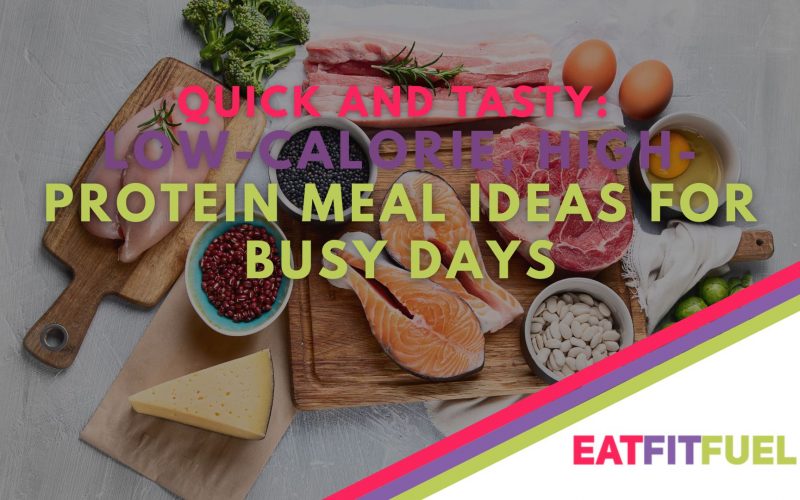Our world has rapidly changed in the age of industrialization. Technology has enabled us to do things faster, like process transactions, coordinate with business partners, communicate with others, etc. We have more ways to manage our time now, but does that mean we have more time?
One psychological study from 2007 found that people are now walking about 10% faster than they used to around the world. The study’s main conclusion is that the world is speeding up, and it’s not good for our health.
Despite being able to do things faster, we often need more time. We find it challenging to find time to prepare nutritious meals that will help us throughout the day.
But eating on the go doesn’t have to mean sacrificing your health. With a little meal prepping in your free time, you can have delicious, high-protein, low-calorie meals ready for your busy days.
This comprehensive article will discuss the best healthy meal ideas that you can prepare in advance and eat when you’re in a rush. We’ll also discuss what you need to know about meal prep so you can get
Overview:
The Need for Quick and Nutritious Meals On-The-Go
The Art of Meal Prepping
Best Low-Calorie and High-Protein Meal Ideas
Healthy Flavor Boosts
Frequently Asked Questions
Conclusion
The Need for Quick and Nutritious Meals On-The-Go
With all the events that have happened in the past few years, like COVID-19 and Russia’s invasion of Ukraine, the world economy is struggling to recover. This takes a toll on everyone, pushing people to work harder and faster to earn a living.
Finding the time to grocery shop, prep, and cook healthy meals can be challenging. According to the National Safety Council, 34.2% of adults ages 20 years and over are overweight, 33.8% are obese, and 5.7% are extremely obese. Poor eating habits and lack of physical activity are major contributors to being overweight and obese in the U.S.
Obesity takes a toll on health and productivity. The National Safety Council reports almost 39 million workdays are lost to obesity-related illnesses yearly. The lack of quick access to nutritious meals is a significant factor in maintaining a healthy weight.
The key to a better lifestyle is learning how to prepare meals in advance so you can have quick and easy meals even on hectic days. It gives you the benefit of healthy meals without the hassle of long preparation time.
The Art of Meal Prepping
Meal preparation, or meal prepping, involves planning and preparing your meals in advance. The prepared meals usually last for a few days or a week.
Meal preparation offers numerous benefits that can lead to a healthier lifestyle without sacrificing convenience and cost-effectiveness. It can be a valuable tool for people who want to improve their diet, save time, and better manage their health.
Here are a few tips that can help you prepare your meals better and more efficiently.
- Set a Schedule
Meal preparation can take a few hours. There’s a lot that needs to be done so you can enjoy the week eating healthy food. There’s grocery shopping, preparing ingredients, storing, and cooking, so meal prep can take a while.
It’s essential to dedicate a few hours on your day off to preparing your meals. This will help you improve your diet and overall health.
- Plan Your Meals
Create a weekly meal plan before you start preparing. Look for multiple high-protein meal ideas that you can make at home. Identify what you’ll have for breakfast, lunch, dinner, and the occasional snack.
Make sure you try to switch it up every now and then so you’re not eating the same food over and over again. You may get tired of repetitive food, which can demotivate you from following your meal plan.
You can schedule one meal for Mondays, Wednesdays, and Fridays and another for Tuesdays and Thursdays. Make sure your snacks are healthy and varied so it’s a small break from your usual food.
Planning your meals can help you identify what ingredients you’ll need. Aim for meals that have similar or flexible ingredients. These are ingredients that can be used for more than just one dish. This minimizes waste and simplifies meal preparation.
When creating a list of ingredients, make sure you go as detailed as possible. Make sure you take note of what you already have and what you’ll need from the grocery store and how much. This helps ensure you get everything you need in just one trip to the store.
- Store Food Properly
Properly storing ingredients for meal prep is crucial in making sure they stay fresh. Specific ingredients have specific ways to store them. Some ingredients need to be stored in the refrigerator, while others need to be stored in a cool, dry place. It’s helpful to familiarize yourself with how you can maximize the shelf-life of the ingredients you need.
Additionally, it’s important to invest in high-quality storage containers. Airtight containers are a good option because they can keep food fresh longer. It’s also good to consider storage that is microwave and dishwasher-safe. This makes reheating and washing dishes much more effortless.
Keep raw meat and fish in airtight containers or resealable bags on the bottom shelf of the refrigerator to prevent cross-contamination.
To get the air out of a resealable bag, you can purchase one of the best vacuum sealers of 2023. These tools will remove air from your containers, creating a vacuum space. This prevents bacteria or mold from growing and prevents freezer burn. This will help extend the shelf life of your food and reduce food waste.
A cheaper alternative would be to put the meat in a resealable bag and then submerge it in water. The pressure of the water will push out any air from the bag, simulating a vacuum.
Different vegetables need to be stored in their specific way to extend their shelf life. For leafy greens, it’s important to store them in airtight containers or resealable bags that are lined with paper towels. This helps absorb any excess moisture, prolonging decay.
For berries, it’s best to keep them dry and store them in the refrigerator in their original containers. Another way to store them is to put them in ventilated containers that are lined with paper towels to absorb moisture.
For root vegetables, it’s best to keep them out of the refrigerator. Store them in a cool dark place in a well-ventilated container or a plastic bag with holes. This is because some root vegetables tend to sprout when they are exposed to warmth and moisture. Additionally, moisture can cause rotting in root vegetables.
For herbs, it’s best to place them in a jar with water like you would with flowers. Wrapping them in a damp paper towel and storing them in the refrigerator is also a good option.
Dried grains and legumes need to be stored in airtight containers in a cool, dry place to prevent moisture and pest contamination. As for cooked grains, they can be stored in the refrigerator for about 3-5 days. You can freeze them in the freezer if you want to preserve them longer.
- Batch Cooking
Meal prepping can take a lot of time, so to make the most out of your efforts, cook in big batches. This one-time cooking should last you for multiple meals throughout the week. It saves time and makes meal preparation more efficient.
- Prep Ingredients in Advance
When you’re getting ready for meal prep, wash, chop, and store your ingredients ahead of time. This makes cooking much easier and faster because all your ingredients are prepared.
- Portion Out Meals
Portioning meals during meal prep is essential for maintaining a balanced diet and controlling calorie intake. Use measuring cups, spoons, and kitchen scales to accurately measure ingredients and control your portion sizes. This helps you stay on track with your diet.
Include a wide variety of nutrients in your meals. Divide each meal into sections for proteins, carbohydrates, vegetables, and healthy fats to ensure a healthy diet. Be mindful of your calories to avoid overeating or undereating.
- Consider Freezing Meals
Freezing meals is an effective way to prolong their shelf life because it significantly slows down the growth of bacteria, yeast, and mold. Freezing food inhibits the growth of microorganisms, prevents them from multiplying, and avoids causing food spoilage.
Additionally, freezing can deactivate enzymes that contribute to the deterioration of food. This helps preserve your meals’ texture, flavor, and nutritional value. Overall, freezing meals can extend their storage time for several months.
Once your meals are frozen, it is easier to have a variety of home-cooked meals available for consumption.
Best Low-Calorie and High-Protein Meal Ideas
The following meals are low in calories and are high in protein. These meals can significantly help with weight management or loss because they help you feel full for longer. They can also help stabilize blood sugars and improve metabolic health.
These quick and easy meals will help you stay healthy even if you’re always on the go.
- Feta and Roasted Red Pepper Stuffed Chicken Breasts
Chicken breast is one of the best protein sources because it contains high-quality protein and is very low in calories. It becomes a Mediterranean-inspired meal perfect for busy weeknights when stuffed with feta cheese and roasted red peppers. This makes it one of the best high-protein meal ideas you can prepare at home.
This flavorful stuffed chicken has 33g of protein and only 318 calories per serving. You can pair it with roasted potatoes and greens for a more balanced meal.
Prep time: 30 mins
Cook time: 25 mins
Ingredients:
- 4 boneless, skinless chicken breasts (6 oz each)
- 1⁄4 cup crumbled feta cheese
- 1⁄4 cup roasted red peppers, drained and chopped
- 2 tbsp olive oil
- 1 garlic clove, minced
- 1⁄4 tsp dried oregano
- Salt and pepper to taste
Cooking Instructions
- Preheat your oven to 400°F. While this is heating up, wash your chicken breast and pat it dry. Slice it lengthwise to create a pocket for the stuffing. Season it with salt and pepper to taste.
- Heat 1 tbsp of olive oil in a skillet over medium heat. Add garlic and cook it for 1 minute or until it becomes fragrant.
- Remove the skillet from the heat and mix in feta and roasted peppers.
- Stuff your chicken pockets evenly with the feta mixture. Use toothpicks to seal up the pockets.
- Place your stuffed chicken on a baking sheet. Brush the top with the olive oil from the skillet and sprinkle a little oregano.
- Roast for 25 minutes or until the chicken is cooked through. Make sure to remove the toothpicks before serving.
- Roasted Salmon with Spicy Cranberry Relish
Salmon is rich in omega-3 fatty acids, vitamin D, and antioxidant selenium and is low in calories. The spicy cranberry relish is tangy and adds some kick to your salmon. It’s the perfect meal if you’re looking for something spicy and festive.
This meal gives you 22g of protein and only 250 calories per 4oz serving.
Prep time: 10 mins
Cook time: 15 mins
Ingredients:
- 4 (4 oz) salmon fillets
- 2 tbsp olive oil, divided
- Salt and pepper to taste
- 1 cup fresh cranberries
- 1⁄4 cup thinly sliced shallot
- 1 tbsp honey
- 1 tsp lemon zest
- 1⁄4 tsp red pepper flakes
Cooking Instructions:
- Preheat your oven to 400°F. Coat the salmon with 1 tbsp olive oil and season it with salt and pepper to taste. Place the salmon skin-side down on a baking sheet.
- Roast the salmon for 12-15 minutes until opaque throughout.
- In a blender, add cranberries, shallot, honey, lemon zest, pepper flakes, and 1 tbsp of olive oil. Pulse the blender until the relish is finely shopped.
- Serve the salmon and top it with the spicy cranberry relish.
- Air-Fryer Pork Chops with Applesauce
Pork chops tend to be unhealthy because they are deep-fried, and they may come out oily when they need to be cooked and prepared well. But cooking pork chops in an air fryer removes the need for oil, and it even trims added fat and calories. This results in a tender and juicy pork chop with sweet and tasty apple sauce.
This meal has 26g of protein and only 179 calories per serving. It’s a great meal if you’re looking for something savory and sweet.
Prep time: 10 minutes
Cook time: 15 mins
Ingredients:
- 1 tbsp olive oil
- 1 tsp smoked paprika
- 1⁄2 tsp garlic powder
- 1⁄2 tsp salt
- 1⁄4 tsp pepper
- 4 (4 oz) bone-in pork chops, patted dry
- 1⁄2 cup unsweetened applesauce
Cooking Instructions:
- Add olive oil, paprika, garlic powder, salt, and pepper in a small bowl. Use this mixture to coat pork chops on both sides.
- Place the pork chop in an air fryer at 370°F for 6 minutes. Flip the pork chops and continue cooking in the air-fryer for 6-9 more minutes until it’s cooked.
- Serve pork chops with 1/4 cup applesauce per serving.
- White Turkey Chili
A white turkey chili is a great meal for when you’re looking for something that can warm you up from the inside out. It’s a filling meal that is generous with protein and less saturated fat compared to beef. For a zesty twist, you can add avocado, cilantro, and a squeeze of lime on top.
Each 1-cup serving of this lean turkey chili gives you 31g of protein and 264 calories. It’s an effortless meal to cook and reheat for when you’re looking for something hearty. It’s also an excellent meal to prepare after Thanksgiving when you have lots of leftover turkey.
Prep time: 15 mins
Cook time: 25 mins
Ingredients:
- 1 tbsp olive oil
- 1 small onion, diced
- 3 cloves garlic, minced
- 1 lb ground turkey (93% lean)
- 2 (15 oz) cans of cannellini beans, rinsed and drained
- 1 (28 oz) can diced tomatoes
- 1 1⁄2 cups low-sodium chicken broth
- 2 tsp ground cumin
- 3⁄4 tsp dried oregano
- 1⁄4 tsp cayenne pepper
- 1⁄4 cup chopped cilantro
- Lime wedges for serving
- Diced avocado for serving
Instructions:
- Heat olive oil in a large pot over medium heat. Cook your onions for 5 minutes until they soften. Add your garlic and cook this for 1 more minute till the garlic becomes golden brown.
- Add your ground turkey and cook slowly. Remember to break the turkey into smaller pieces as it is brown.
- Add the remaining ingredients except for the cilantro, lime, and avocado. Bring the mixture to a boil, then reduce heat and simmer for 20 minutes for flavors to meld.
- Serve the chili in bowls and top it with cilantro, avocado, and lime juice.
Vegetarian Protein Alternatives
The previous meals we discussed focused on lean meals. Still, we also want to offer vegetarian alternatives for everyone who prefers this diet.
The World Health Organization indicates that 80% of heart disease, stroke, and Type 2 diabetes could be prevented by having a healthier diet. This includes more plant-based meals that give you vitamins, nutrients, and the same high-quality proteins.
Here are a few nutritious, high-protein vegetarian dishes that you can prepare ahead of time for quick meals.
- Sheet Pan Ginger Miso Tempeh with Green Beans
Tempeh is made from fermented soybeans, and it’s high in protein, vitamins, calcium, and minerals but is low in sodium and carbs. Tempeh goes great with vitamin-rich green beans and a zesty miso glaze. This sheet pan meal comes together in just 30 minutes. This is one of the best high-protein meal ideas if you’re a vegetarian.
This meal gives you 29g of protein per serving, tons of vitamins, minerals, and fiber, and only 354 calories. It’s perfect for nights when you’re looking for something easy to prepare and cook.
Prep time: 10 mins
Cook time: 20 minutes
Ingredients:
- 1 lb tempeh, cut into 1-inch cubes
- 12 oz green beans, trimmed
- 2 tbsp white miso paste
- 1 tbsp maple syrup
- 1 tbsp olive oil
- 2 tsp minced ginger
- 1 garlic clove, minced
Instructions:
- Preheat your oven to 375°F. Line a large baking sheet with parchment paper.
- Whisk together the miso, maple syrup, olive oil, ginger, and garlic in a small bowl to create a glaze. Set aside at least 2 tbsp for glazing later.
- Add the tempeh and green beans to the baking sheet. Drizzle the glaze and toss to coat the ingredients.
- Bake the tempeh and green beans for 20 minutes until the tempeh is browned. Drizzle the remaining glaze before serving.
- Vegan Breakfast Grain Bowl
This bowl is made up of quinoa, sweet potatoes, chickpeas, avocado, and pumpkin seeds. Quinoa is an excellent plant protein, fiber, and other vitamins and minerals source. It’s a complete protein because it contains all nine essential amino acids that the body can’t make on its own.
This healthy vegan bowl gives you 21g of plant-based protein and 333 calories per serving. It’s a quick, easy, and healthy way to start your morning!
Prep time: 10 mins
Cook time: 30 mins
Ingredients:
- 1 cup uncooked quinoa
- 1 large sweet potato, peeled and diced
- 1 (15 oz) can chickpeas, drained and rinsed
- 2 cups baby spinach
- 1 avocado, sliced
- 2 tbsp olive oil
- 1 lime, juiced
- 1⁄4 cup pumpkin seeds
- Salt and pepper to taste
Instructions:
- Cook quinoa according to package instructions. Add diced sweet potato in the last 5 minutes of cooking.
- While the quinoa is cooking, clean the chickpeas by rinsing them. Heat up 1 tbsp of olive oil on a skillet over medium heat. Pan-fry the chickpeas for 6-8 minutes until they become crispy.
- Toss spinach with lime juice and 1 tbsp of olive oil in a bowl. Sprinkle salt and pepper to taste.
- Scoop quinoa and sweet potato into your bowl. Top the dish with chickpeas, spinach, avocado, and pumpkin seeds.
Healthy Flavor Boosts
Preparing healthy flavor boosts is a great way to enhance the taste of your meals without relying too much on salt, sugar, or unhealthy fats. These flavor boosts will help you enjoy delicious meals more healthily!
- Herb Blends
Create herb blends using fresh or dried herbs like basil, rosemary, thyme, oregano, and parsley. Mix them with olive oil, lemon juice, or vinegar to make a versatile and healthy dressing or marinade.
- Citrus Zest
Use the zest of citrus fruits like lemons, limes, and oranges to add a burst of flavor to your dishes. Citrus zest can be added to salads, marinades, dressings, and sauces.
- Homemade Spice Mixes
Preparing your own spice mixes for a little kick in your meals is easy. Mix together cumin, paprika, turmeric, cinnamon, and chili powder. These spices are great for seasoning vegetables, meats, and grains.
- Roasted Garlic
Slice off the top of the head of garlic and drizzle a little olive oil. Sprinkle a little salt and pepper to taste and wrap it in foil. Roast your garlic for 40-60 minutes until they turn golden and soft.
You can add herbs to this mixture and use it to enhance sauces, soups, or seasoning. It’s best to add some butter to this mixture and spread it on bread to create healthy and tasty garlic bread.
- Caramelized Onions
Slowly cook sliced onions in a small amount of olive oil until they caramelize and turn golden brown. These caramelized onions can be added to sandwiches, salads, or as a sweet topping for meat to enhance the flavor.
- Infused Oils and Vinegars
Make your own infused oils and vinegar by adding fresh herbs, garlic, or chili peppers to olive oil or vinegar. If you’re using fresh herbs or other ingredients, ensure they are thoroughly washed and completely dry before adding them. Excess moisture can lead to the growth of bacteria and mold.
- Toasted Nuts and Seeds
Almonds, sesame seeds, or pine nuts are good for toasting because they enhance their nutty flavor. Sprinkle toasted nuts and seeds over salads, yogurt, or stir-fried vegetables for added interesting texture and taste.
Frequently Asked Questions
What foods are high in protein but low in calories?
Chicken, lean cuts of red meat, turkey, fish, seafood, egg whites, plain Greek yogurt, and cottage cheese are good sources of protein. For plant-based sources of protein, go for tofu, tempeh, beans, lentils, and edamame.
Can your diet focus on high-protein and low-calories?
This diet is healthy and ideal. Focus on getting protein from natural, minimally processed sources like poultry, fish, eggs, yogurt, beans, legumes, nuts, and seeds. Pair them with low-calorie fruits and vegetables instead of refined carbs like white bread, pasta, and sweets.
How do you eat high protein and low calories on a budget?
Budget-friendly protein sources are eggs, canned tuna, chickpeas, lentils, Greek yogurt, cottage cheese, beans, peanut butter, tofu, and tempeh. Chicken thighs and drumsticks are also budget-friendly, depending on where you are. It’s ideal to buy produce in season, so they’re cheaper. You can also save more money if you buy during sales and in bulk.
Conclusion
Creating a list of low-calorie high-protein meal ideas to enjoy on your most hectic days is one of the best investments you can make for your health. It’s good to dedicate time in your week to shop for groceries and meal prep. This ensures that you always have nutritious options on hand.
You should include many lean proteins, complex carbs, fibers, and ample produce in your meal prep. You can also prepare flavor enhancers made of spices, herbs, and aromatics to make your meals even tastier.
With proper planning and a little patience and practice, you’ll have quick, tasty, and healthy meals ready on the go. Soon enough, you’ll start seeing improvements in your health and body!e






